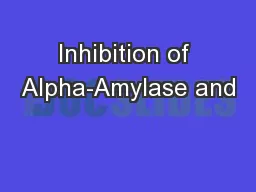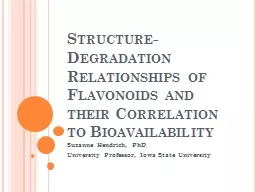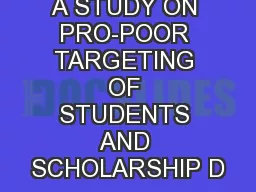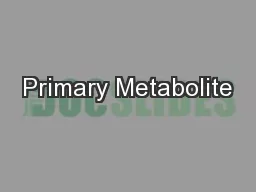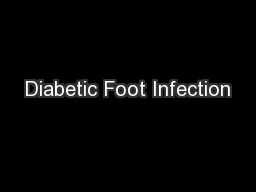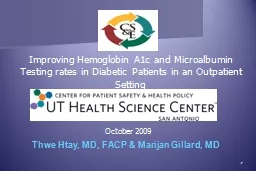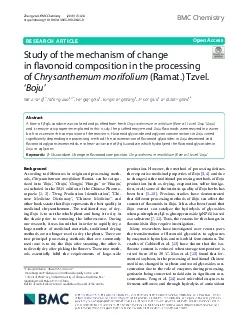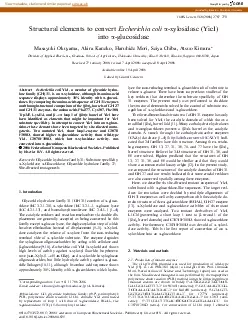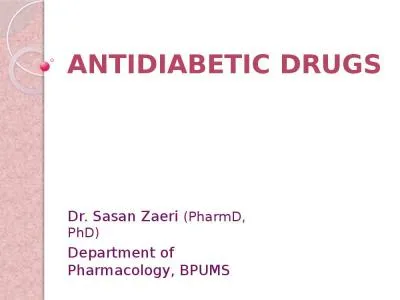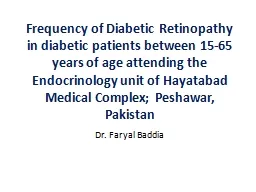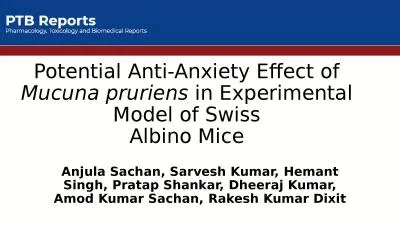PPT-Prediction of anti-diabetic activity of flavonoids targeting α-glucosidase
Author : vivian | Published Date : 2022-06-07
Marisa Freitas Adelaide Sousa Daniela Ribeiro Eduarda Fernandes Introduction Diabetes mellitus is a pandemic disease and is one of the main threats to human health
Presentation Embed Code
Download Presentation
Download Presentation The PPT/PDF document "Prediction of anti-diabetic activity of ..." is the property of its rightful owner. Permission is granted to download and print the materials on this website for personal, non-commercial use only, and to display it on your personal computer provided you do not modify the materials and that you retain all copyright notices contained in the materials. By downloading content from our website, you accept the terms of this agreement.
Prediction of anti-diabetic activity of flavonoids targeting α-glucosidase: Transcript
Marisa Freitas Adelaide Sousa Daniela Ribeiro Eduarda Fernandes Introduction Diabetes mellitus is a pandemic disease and is one of the main threats to human health Figure 1 Global projection for diabetes epidemic 20112030 . By. . SOMESHWAR.K. M.PHARM.. II - SEMESTER . . . Department of Pharmaceutics. University College of Pharmaceutical Sciences,. KAKATIYA UNIVERSITY. Alpha-. G. lucosidase. by . Bioflavanoids. : . In Vitro. and . In Vivo. Studies . Anneke Tucker. Dr. Meltem Musa. Dr. Balz Frei. HHMI Symposium Presentation . September 23, 2010. The Problem. TYPE II DIABETES MELLITUS . Definition of Terms: . Targeting. : Defines the people who are eligible for assistance by your program. Determines every aspect of your program, from outreach to community partnerships. Serves as the basis for screening.. Suzanne Hendrich, PhD. University Professor, Iowa State University. Learning outcomes. Identify key flavonoid structures & classes. Identify key food sources of major dietary flavonoids. Describe structure/activity relationships influencing bioavailability of flavonoids. IN NEPAL. BY. Tara . Chouhan. Monitoring and Evaluation . Officer. Student Financial Assistance Fund Development Board. A. Meaning of PMT. PMT is based on national household surveys. Given that household income in developing countries is often difficult and expensive to measure accurately, the methodology relies on household assets and other indicators or proxies to estimate household welfare.. Secondary Metabolites. 1) Primary metabolites are essential. for life process. . (Growth of. the cells. ). These. are non-essential.. 2)These are. identified universally, throughout the source.. These are seldom, like in some portions of the source, like steam, bark, etc.. (DR) . Ayesha S Abdullah. 03.01.2014. Learning outcomes. By . the end of the lecture the students would be able . to;. Describe the epidemiology of DR. Correlate the pathogenesis of DR with the clinical . Of all the late complications of diabetes, foot problems are probably the most preventable. . Joslin. , who wrote in 1934 that “diabetic gangrene is not heaven-sent, but earth-born. Approximately 5% to 10% of diabetic patients have had past or present foot ulceration, and 1% have undergone amputation. October 2009. Thwe Htay, MD, FACP & Marijan Gillard, MD. Overview. Project completed in the outpatient Primary Care Clinic ( Medical Art and Research Center-MARC) at the University of Texas Health Science Center at San Antonio.. glycosides improved its antioxidant ecacy Zhang etal al 15 found that hydrolysis of Apocynum venetum avonoid glycosides improved the extraction of avonoids from its leaves and thus its antidepressant 2006FederationofEuropeanBiochemicalSocietiesPublishedbyElsevierBVAllrightsreservedGlycosidehydrolasefamily31Substratespecicity-GlucosidaseGlycosidehydrolasefamily27Site-directedmutagenesis1Introductio Sasan. . Zaeri. . (. PharmD. , PhD). Department of Pharmacology, BPUMS. . Diabetes mellitus (DM). The most common metabolic disease . Chronic hyperglycemia. Biochemical. criteria. Normal. Prediabetic. Dr. Faryal Baddia. Objectives. General. Specific. Type of study design. Data collection method. “. Guidelines for developing DR Program in India. . By . Arvind. Eye Care System.”. Materials & Methods. Mucuna pruriens . in Experimental Model of Swiss. Albino Mice. Anjula Sachan, Sarvesh Kumar, Hemant Singh, Pratap Shankar, Dheeraj Kumar, Amod Kumar Sachan, Rakesh Kumar Dixit. The usage of benzodiazepines, the major class of anxiolytic drugs is invariably accompanied by many side-effects like sedation and muscle relaxation leading to incoordination of movements. Search for novel anxiolytic agents have identified flavonoids as potential compounds devoid of these adverse effects. Mucuna pruriens commonly known as cowhage plant has been claimed to possess various beneficial effects like anti-parkinsonian, anti-tumor, neuroprotective, antioxidant, anti-diabetic and antimicrobial activities. Previous studies have reported that Mucuna pruriens contains LDOPA and 5-hydroxy tryptophan (5-HT) as a major constituent with higher concentration in seeds. .
Download Document
Here is the link to download the presentation.
"Prediction of anti-diabetic activity of flavonoids targeting α-glucosidase"The content belongs to its owner. You may download and print it for personal use, without modification, and keep all copyright notices. By downloading, you agree to these terms.
Related Documents


